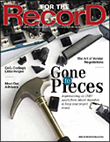September 4 , 2007
 Coding for Kidney Stones
Coding for Kidney Stones
For the Record
Vol. 19 No. 18 P. 30
Kidney stones are caused by an excess of calcium, oxalate, and uric acid in the urine. These stones may occur anywhere within the urinary tract and are due to overexcretion of salt or reduced excretion of urine. The ICD-9-CM code assignment for kidney stones is 592.0. Other terms listed under code 592.0 include the following:
• Calculus of kidney;
• Nephrolithiasis, not otherwise specified;
• Renal calculus;
• Renal stone;
• Staghorn calculus; and
• Stone in kidney.
A kidney stone associated with gout is classified to code 274.11, Uric acid nephrolithiasis. ICD-9-CM assumes the kidney stone is acquired. If it is a congenital kidney stone, then assign code 753.3. Kidney stones may be common in premature infants. The following are code assignments for stones located in other parts of the urinary tract:
• Bladder — 594.1;
• Diverticulum of bladder — 594.0;
• Ureter/ureteropelvic junction — 592.1;
• Urethra — 594.2;
• Other lower urinary tract — 594.8;
• Unspecified part of lower urinary tract — 594.9; and
• Unspecified site of urinary system — 592.9.
Kidney stones vary in size from a staghorn calculus that may fill the entire renal pelvis and calices to microscopic crystalline foci.
Symptoms
Some kidney stones may be asymptomatic. However, when symptoms are present, it is often described as the worst pain ever experienced. A patient with kidney stones may present with flank pain on one or both sides, back pain, nausea and vomiting, urinary frequency, painful urination, abdominal pain, chills, and/or fever.
Hematuria, or blood in the urine, is also a common symptom of kidney stones. However, since hematuria is usual with kidney stones, it should not be assigned as a secondary diagnosis. It is considered an integral part of the condition, and therefore, according to coding guidelines, cannot be assigned as a secondary diagnosis (AHA Coding Clinic for ICD-9-CM, 1995, third quarter, page 8 and 2006, fourth quarter, page 149).
Complications
The following are complications associated with kidney stones. If present and treated during the hospital stay, they may be coded as a secondary diagnosis:
• Hypercalcemia/hypercalcinuria — 275.40;
• Hydronephrosis (591) — often an indicator of an obstructing stone;
• Secondary hypertension (405.x9);
• Obstructive uropathy — 599.60;
• Pyelonephritis (590.xx); or
• Urinary tract infection (599.0) — when stones block the flow of urine, bacteria becomes trapped thereby causing an infection.
Diagnosis
Some diagnostic tests that detect the presence of kidney stones include abdominal x-rays, intravenous pyelogram, kidney ultrasound, retrograde pyelogram, abdominal CT scan, and abdominal/kidney MRI.
Urinalysis may show hematuria and an increased white blood cell count (pyuria), which may indicate an infection in the kidneys or throughout the body.
Treatment
Kidney stone treatment depends on the stone type and size. The stone may pass spontaneously. However, if intervention is taken, extracorporeal shock wave lithotripsy (ESWL) is the most common procedure. ESWL (98.51) uses shock waves to fragment the stone. The small pieces then pass in the urine. Code 98.51 includes removal of calculus by shock waves from any area in the urinary system (eg, kidney, bladder, renal pelvis, ureter). Other procedures for the removal of calculus include the following:
• Lithotripsy of kidney — 56.0;
• Lithotripsy of bladder — 57.0;
• Lithotripsy of urinary bladder with ultrasonic fragmentation — 57.0 + 59.95 AHA Coding Clinic for ICD-9-CM, 1996, first quarter, pages 10-11);
• Basket extraction of stone via transurethral approach (without incision) — 56.0 (AHA Coding Clinic for ICD-9-CM, 1994, fifth issue, page 5 and 1989, first quarter, pages 1-3);
• Basket extraction of stone via percutaneous lithotripsy — 55.03;
• Transurethral ureteroscopic lithotripsy using laser to fragment the stone — 56.0 (AHA Coding Clinic for ICD-9-CM, 1989, first quarter, page 1);
• Cystolithotomy — 57.19;
• Percutaneous nephrostomy without fragmentation — 55.03;
• Percutaneous nephrostomy with fragmentation (eg, ultrasound) — 55.04; and
• Removal of kidney stone by nephrotomy — 55.01.
Once a patient has had a kidney stone, the chance of recurrence is likely.
Coding and sequencing for kidney stones are dependent on the physician documentation in the medical record and application of the Official Coding Guidelines for inpatient care. Also, use specific AHA Coding Clinic for ICD-9-CM and American Medical Association CPT Assistant references to ensure complete and accurate coding.
— This information was prepared by Audrey Howard, RHIA, of 3M Consulting Services. 3M Consulting Services is a business of 3M Health Information Systems, a supplier of coding and classification systems to nearly 5,000 healthcare providers. The company and its representatives do not assume any responsibility for reimbursement decisions or claims denials made by providers or payers as the result of the misuse of this coding information. More information about 3M Health Information Systems is available at www.3mhis.com or by calling 800-367-2447.



